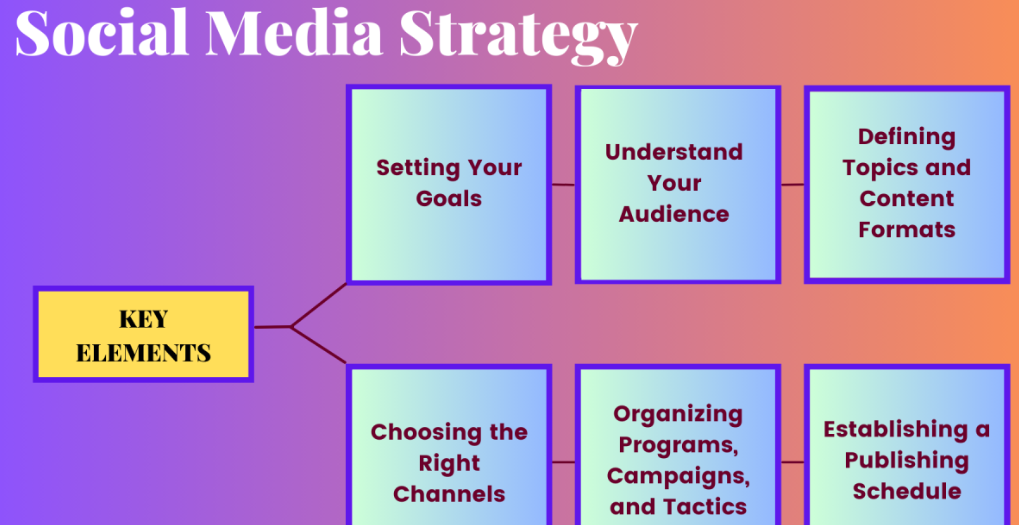Imagine telling the story of your brand to millions, engaging customers at their convenience and turning followers into loyal advocates. That is the power of an effective and well-executed social media strategy. It goes beyond just posting content; it is about strategically using every social platform to build meaningful connections, initiate action and achieve real growth for your business.
A social media strategy is the driving force behind why you post the content that you share and choose the social media platforms that you have selected. It outlines your social media goals and the metrics that you use to measure the success. The strategy gives direction to your marketing efforts and gives you clarity on what success looks like.
The following article will show you how to create a social media strategy that goes beyond the basics. It will teach you how to come up with a strategy that aligns with your business goals, keeps your audience hooked and puts you ahead of the competition in 2025 and beyond.
What is a Social Media Strategy?
A social media strategy is a plan that outlines the steps brands and marketers take to achieve larger business goals through social media. A well-defined plan empowers teams to build effective social media campaigns, thereby boosting organic growth, brand perception, competitive advantage and driving demand.
Components of an Effective Strategy for Social Media
There are several components of a social media strategy but, the following are the most important ones that you should emphasize on.
- Goals and Objectives: Define clear, measurable goals that resonate with your business objectives. That will ensure your social media efforts drive real results.
- Audience Research: Understand the interests of your target audience, their behaviors and preferences to tailor your strategy and create relevant, engaging posts.
- Content Strategy: Come up with a content plan that adds value to your audience, ensuring consistency and variety across your social media channels.
- Platform Selection: Choose the right social media platforms depending on where your target audience spends most of their time and how they prefer to engage with content.
- Engagement Strategies: Create plans to actively interact with your audience, driving conversations, building community and promoting brand loyalty.
- Analytics and Metrics: Track key performance indicators (KPIs) to measure the success of your social media activities and adjust your strategy accordingly.
- Schedule and Frequency: Maintain a consistent posting schedule and determine the best times to post content for your audience to maximize engagements and reach.
- Budget and Resources: Allocate resources wisely, taking into considerations both your budget for paid ads and the human resources required for content creation and management.

Steps to Creating a Successful Social Media Strategy
Follow the steps outlined below to create a powerful social media strategy for your business.
- Set SMART Goals and Objectives
Every successful social media strategy must be deeply rooted in goals and objectives. Goals define your next steps and your key performance indicators. Examples of a goals and objectives that you can set include boosting brand awareness, engagement and conversion rates. You should emphasize SMART goals (specific, measurable, achievable, realistic and time-bound).
Here’s how you can approach setting goals and objectives for your social media strategy.
Brand awareness
Brand awareness refers to the degree to which consumers recognize and remember a brand through its social media presence or activities. It is more about creating a positive perception of your brand through the following;
- Consistently posting content that adds value to your audience
- Engaging in meaningful interactions
- Consistent branding
- Strategic partnerships and collaborations
So, how can you drive brand awareness for your business on social media? The following steps can help you to achieve that.
- Focus on the social media platforms where your audience spends most of their times.
- Limit your efforts to a few key platforms instead of trying to be on every platform at once.
- Use logos or watermarks to associate content with your brand
- Implement a social media style guide that gives you a competitive advantage on crowded platforms and builds recall.
- Use signature taglines, hashtags and slogans to reiterate your brand message.
Lead generation
Social media leads are the people who are showing interest in your products and services by engaging with them on social media. Those potential clients express interest through requesting callbacks or submitting contact forms.
A good example is the deodorant brand, Wild. They regularly share enticing deals, reviews and testimonials to show brand value to potential leads. Bizrate Insights say up to 91% of consumers often check at least one review before making a buying decision.

Community building
Social media communities are groups of people who come together online to share common interests and experiences. They can include forums, chat rooms and social networking sites where members interact, support each other and share information.
A thriving social media community promotes meaningful connections, powerful word of mouth and strong brand affinity. It can also help with amplifying your presence on social media and the acquisition of new customers.
Flexibility is an important element when setting SMART goals and objectives for your social media strategy. You should be flexible enough to make adjustments whenever you spot an opportunity. Instead of sticking to rigid plans, maintain a watchful eye on what resonates with your audience and be ready to serve them in the ways that appeal to them most.
While there is condition on the number of goals and objectives that you must set, it is best to have a maximum of three goals. That will help to simplify the focus of your social media efforts. If you have a social media team, you can layer more goals and assign specific tasks to each person.
- Research your Audience
When creating a social media strategy, it is also very important that you research your audience and find out their demographics, behaviors, pain points and needs. That will enable you to personalize your content, marketing campaigns and ads that are relevant to your audience.
According to a study by McKinsey, 71% of consumers expect customized experiences from the brands and up to 76% often feel frustrated when they do not get them.
Tips for researching your audience
Quantitative research
This type of research focuses on gathering measurable data such as facts, statistics and figures that give an overview of your audience segment. The data integrates social media demographics such as gender, age, location and profession. It can also incorporate behavioral insights like buying habits and online activities. Social media management tools such as Google Analytics and platform-based analytics can help you to conduct research and collect quantitative data.
Qualitative research
Qualitative research focuses on non-numerical audience insights such as preferences, habits and experiences. You can collect the data through analyzing customer reviews, feedback, interviews, survey responses and Frequently Asked Questions (FAQs). Besides, qualitative research can also explore psychographics like interests, lifestyles and opinions through surveys, feedback forms and questionnaires.
There are essential things about your audience that you should understand to create content that genuinely helps them. The following are the fundamental insights that you should gather when researching your target audience.
- Basic audience demographics including their age, gender, location, job title and salary.
- Jobs to be done or the goals that your target audience are looking to accomplish with your products or services.
- The key challenges, pain points or struggles that your product or service can alleviate.
- The specific social media platforms where your target audience hangs out online.
- The types of content that your audience loves such as educational, entertaining, funny, relatable and video vs image posts.
- The influencers or thought leaders that your audience trust and follow on social media.
- Identify Target Social Media Platforms
With an ever growing list of social media platforms but, limited resources and time, choosing where to focus your efforts can be daunting. Thus, platform selection is a crucial step in creating a successful social media strategy. Identifying a narrow list enables you to channel your efforts effectively and reduce redundancy. So, what should you consider when selecting a social media platform?
The following are the key considerations for choosing ideal social media platforms for your strategy.
Audience preferences
Every platform serves a unique purpose and appeals to specific audience demographics. Thus, you should segment your audience depending on location, interest and age, making sure that the selected platforms cater to important segments.
Cross-platform synergy
Go for platforms that complement each other to create a more powerful and effective social media strategy. For example, you can share visually striking product images and videos on Instagram. Then, use Facebook’s advanced targeting options to reach Instagram followers with customized ads.
Platform features and algorithms
Evaluate the advertising capabilities, targeting options and business features of every social media platform to see if they meet your needs. You should also decode platform algorithms and watch updates closely to pick the best fit for your brand.
Competitive analysis
Take cues from your social media competitors. Observe their platform mix, posting frequency and engagement tactics to learn and identify opportunities for adapting your approach.
When you are starting out, it is advisable to focus on creating content for a single social media platform. You can repurpose the content for other social platforms but, develop content for one platform only. That will enable you to avoid creator burnout and focus your efforts strategically for success. Besides, you do not need to expand your social media presence to all platforms to execute an effective social media strategy.
- Determine a Unique Brand Identity
Brand identity encompasses a unique voice and persona. Brand voice refers to the core values and mission of a brand, demonstrated through consistent tone, style and language across all platforms. On the other hand, a social media persona is about adapting your voice based to align with your audience’s expectations and the dynamics of the platform. A brand voice is static while a social media persona keeps shifting.
For example, Harley Davidson has a bold, rugged and rebellious brand voice that resonates with its target audience who seek thrills, freedom and exploration. The brand takes on a different persona on different platforms with unique marketing tactics.

Their Instagram page has visually striking storytelling with images and videos showcasing riders’ adventurous moments.
Harley-Davidson Twitter page showcases short and impactful interactions along with trendy posts, motivational messages or witty responses.
Their Facebook page has long-form storytelling and interactive posts that feature riders overcoming weather challenges.
Regardless of the persona, Harley-Davidson always has bouts of thrill and adventure in their social media. That kind of consistency can go a long way in winning trust and credibility in the saturated social media market.
A successful social media strategy is not just about creating content; it is about developing content that drives action and promotes meaningful connections. Whether you are looking to boost brand awareness, drive sales or build customer loyalty, having a solid strategy is essential to success. At Superior Social Boost, we help brands and businesses to drive organic growth on social media. We offer customized packages to boost your reach and engagement on Facebook, TikTok, Instagram, X, YouTube and Google Business. Get in touch with us today to transform your social media efforts into powerful campaigns that generate real results for your brand.

